You are using an out of date browser. It may not display this or other websites correctly.
You should upgrade or use an alternative browser.
You should upgrade or use an alternative browser.
My Electric Brewery - Build Update
- Thread starter chastuck
- Start date

Help Support The Homebrew Forum:
This site may earn a commission from merchant affiliate
links, including eBay, Amazon, and others.
I previously posted in instalments the construction of My Electric Brewery and since completing the project I have made further changes in the light of using it. The first alteration arises because of the long length of the combined ball valve and T piece temperature probe on the output of the HLT. This is not a problem when the HLT pot is in situ, but has caused difficulties when trying to store the pot. I do not have much storage space in my property, so all my brewing pots are stored in the loft. Despite recently enlarging the size of the loft hatch, I found that the length of the output arrangement, plus the diameter of the pot, was too long to clear the opening of the loft. I therefore have rebuilt the connection of the ball valve to the HLT utilising a male cone seat union. This means that the tap assembly and attached temperature probe T piece can be easily unscrewed for storage purposes. Disconnected, this has given me 6.5 inches less pot width to try and squeeze into the loft - it just about fits through the loft hatch now! The new ball valve arrangement is shown below:

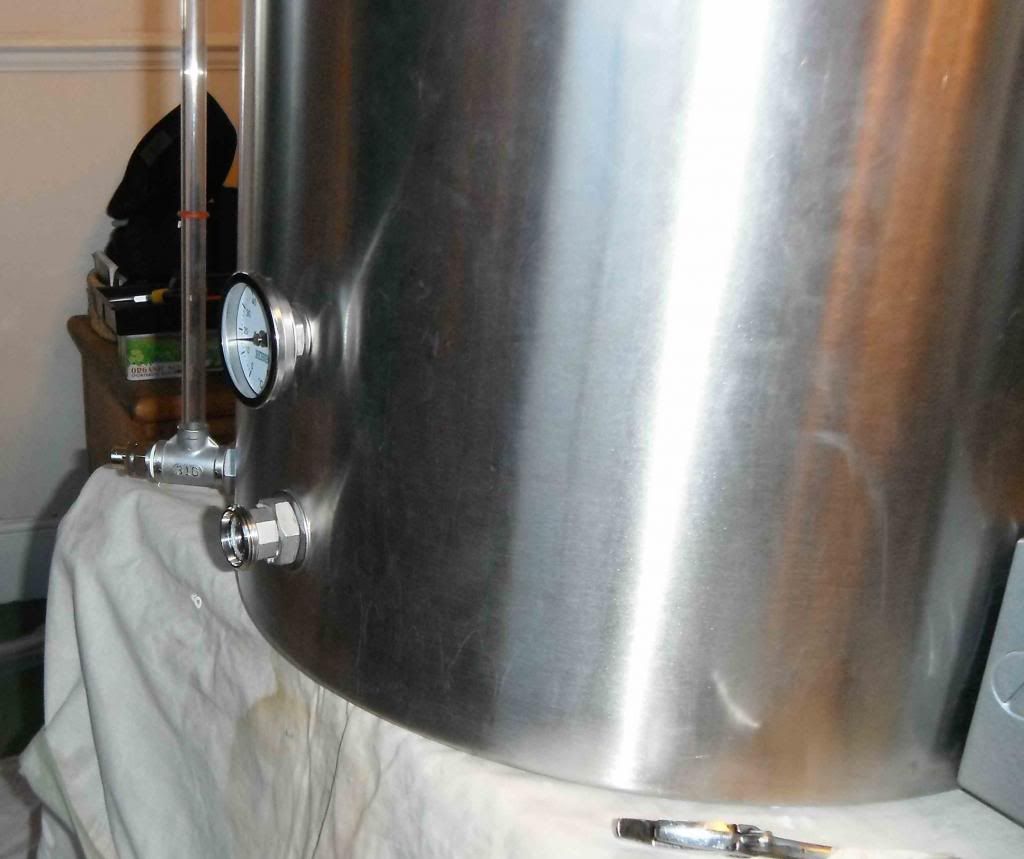

The second change I have made concerns the HERMS set up. As I have previously indicated, the inspiration for My Electric Brewery has come from the US Electric Brewery site: http://www.theelectricbrewery.com/. Their HLT pot has a HERMS heat exchanger coil built inside it. Originally, I proposed to ignore this and continue to use my modified separate HERMS pot (http://www.thehomebrewforum.co.uk/viewtopic.php?f=13&t=48771&sid=f7c8c598571ebfe4e82c37f20891f942). However, I decided I would like to try their arrangement as an alternative, if only for the fact that it means one less pot on the brew stand. So I have gone ahead and fitted a stainless steel coil that is 1/2 inch od and 50ft long. The dimensions of the coil in the pot are 15.5 inches diameter and 7 inches high. It is mounted to the pot by stainless steel stud compression fittings on 1/2 inch BSP ball valves, fitted in the weldless manner I have used before. It sits low in the pot about a quarter-inch above the element. Keeping the coil as low possible in the kettle ensures that the coil will remain submerged as much as possible as you use up water from the HLT. I do not like the idea of fitting something in a pot that cannot be easily removed, so once again I have used cone seat unions on the coil input and out valves to enable its easy removal. Pictures below show the coil fitting.
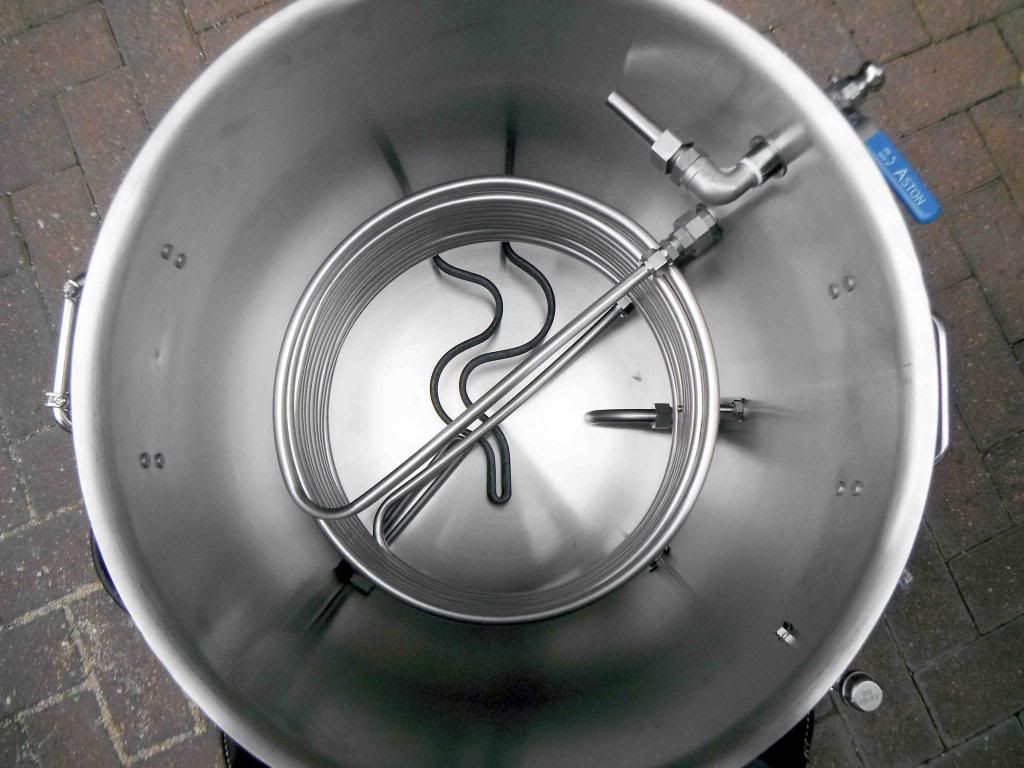

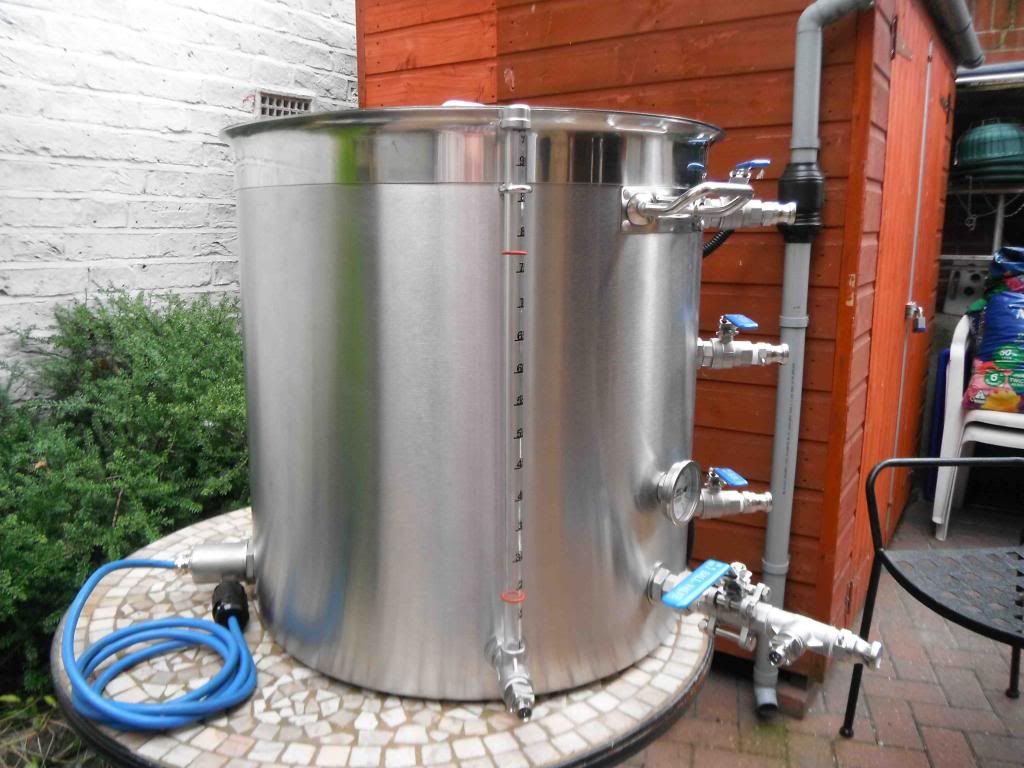
I know that there has been quite a lot of debate on the Forum as to whether a large HERMS coil in a large pot can be as effective as perhaps a small coil in a domestic kettle. The key concern being whether the temperature response time is too slow in a large set up. Anyhow, I thought I would give it a try. If I find the arrangement does not work to my satisfaction over time I will take the coil and ball valves out and close the holes off neatly with blanking plugs. Since fitting the coil I have carried out one brew with it and so far it seems to work well with no excessive delay in terms of temperature control.
The last refinement to the HLT is the fitting of an additional element - you can just see it to the left under the coli in the interior photo of the pot above. I found that, due to its size, the pot was taking a long while to get to temperature. I bought one of angelhomebrew's 2400w stainless steel elements and it has really made a difference to rise times. To control this element in tandem with the existing 5500w element in the pot, I have constructed a stand-alone relay and switch box with its own 25 amp SSR. This is connected to control lines in the control panel via a breakout Speakon 4 way panel connector. This means that the extra 10 amps I need for the new element is not running through the control panel - I was concerned that it would overload the control panel at over 32 amps with both elements on. See pictures below. I have since made the extra element modification to the boil kettle as well.
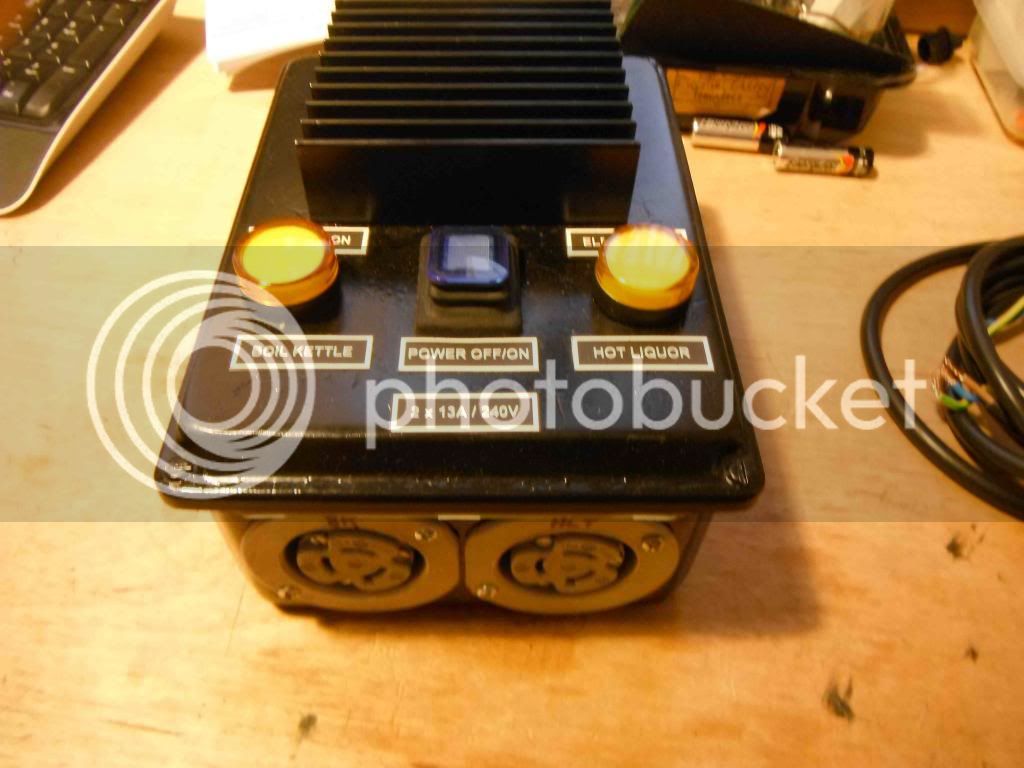
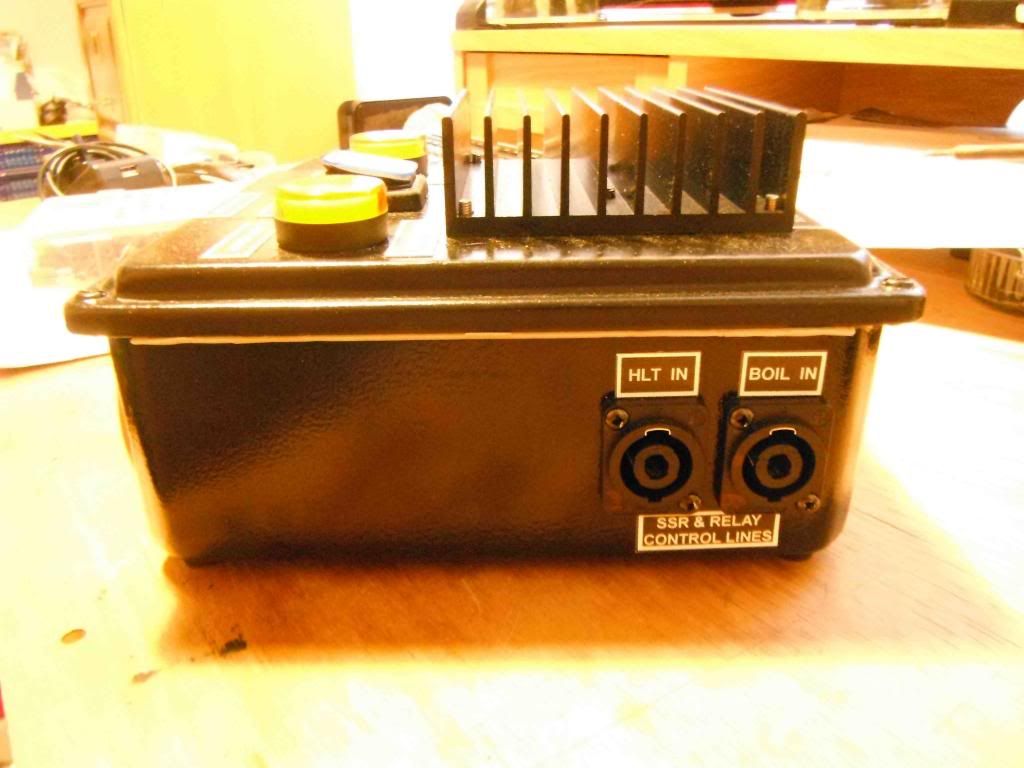
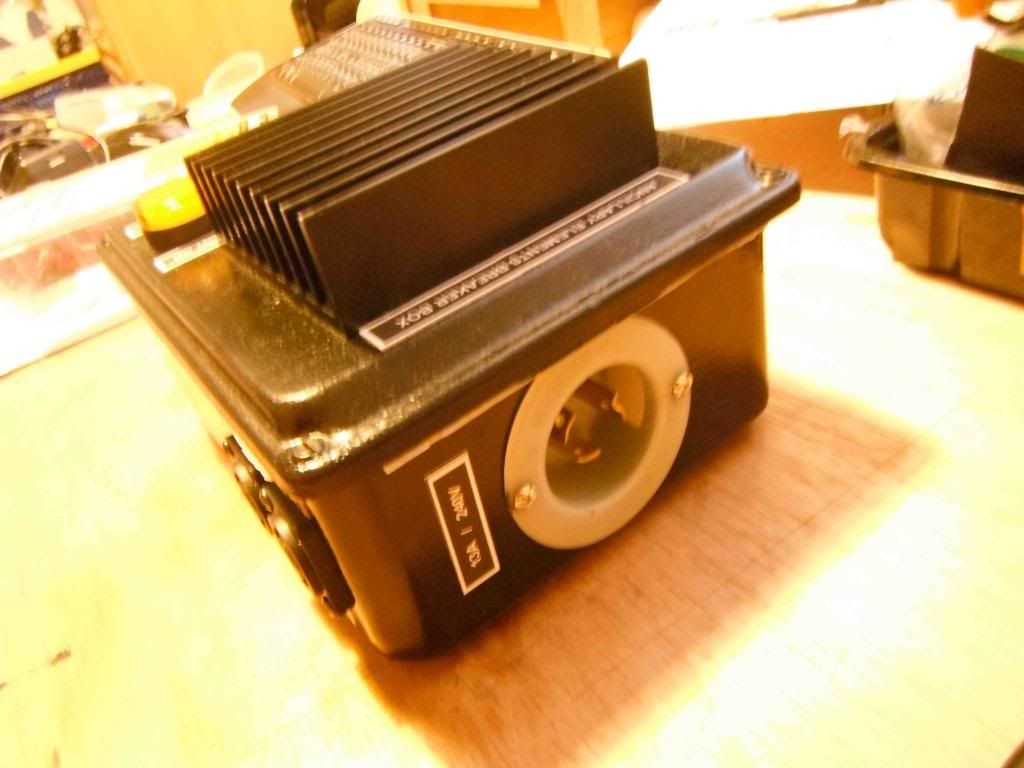
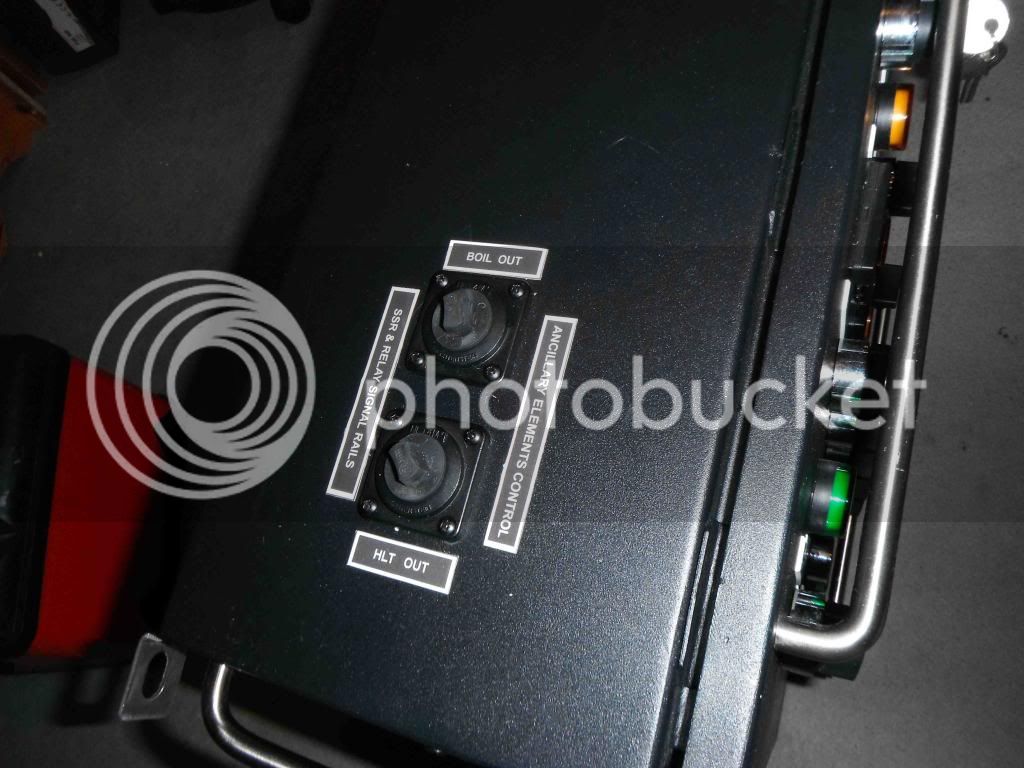
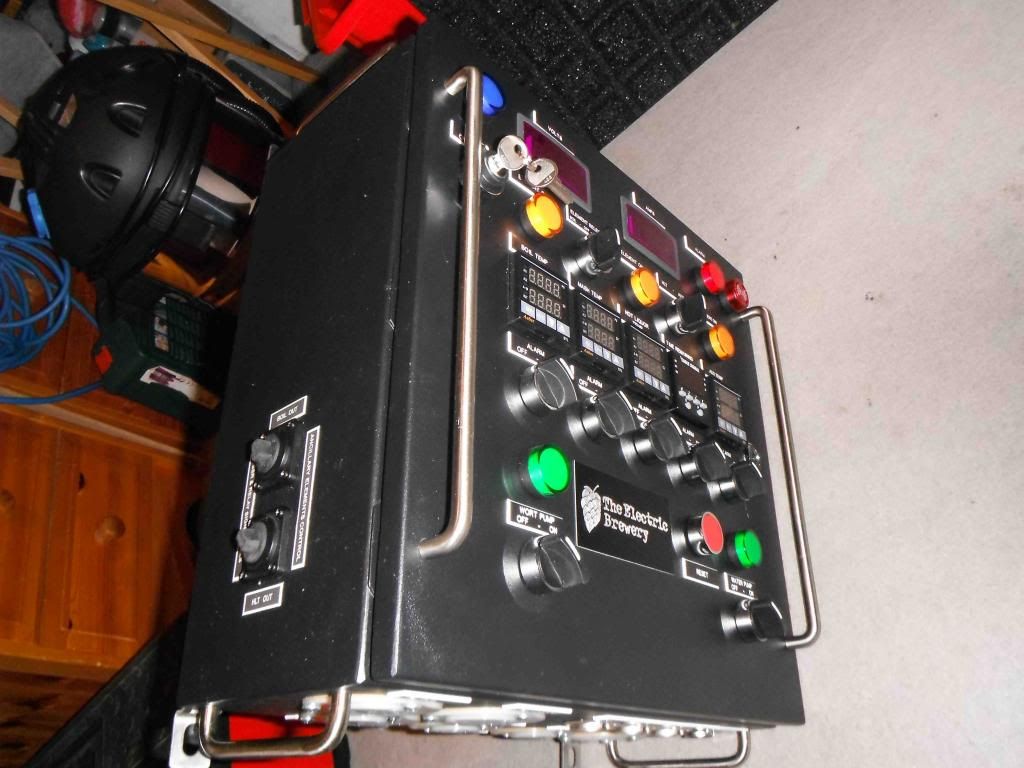



The second change I have made concerns the HERMS set up. As I have previously indicated, the inspiration for My Electric Brewery has come from the US Electric Brewery site: http://www.theelectricbrewery.com/. Their HLT pot has a HERMS heat exchanger coil built inside it. Originally, I proposed to ignore this and continue to use my modified separate HERMS pot (http://www.thehomebrewforum.co.uk/viewtopic.php?f=13&t=48771&sid=f7c8c598571ebfe4e82c37f20891f942). However, I decided I would like to try their arrangement as an alternative, if only for the fact that it means one less pot on the brew stand. So I have gone ahead and fitted a stainless steel coil that is 1/2 inch od and 50ft long. The dimensions of the coil in the pot are 15.5 inches diameter and 7 inches high. It is mounted to the pot by stainless steel stud compression fittings on 1/2 inch BSP ball valves, fitted in the weldless manner I have used before. It sits low in the pot about a quarter-inch above the element. Keeping the coil as low possible in the kettle ensures that the coil will remain submerged as much as possible as you use up water from the HLT. I do not like the idea of fitting something in a pot that cannot be easily removed, so once again I have used cone seat unions on the coil input and out valves to enable its easy removal. Pictures below show the coil fitting.



I know that there has been quite a lot of debate on the Forum as to whether a large HERMS coil in a large pot can be as effective as perhaps a small coil in a domestic kettle. The key concern being whether the temperature response time is too slow in a large set up. Anyhow, I thought I would give it a try. If I find the arrangement does not work to my satisfaction over time I will take the coil and ball valves out and close the holes off neatly with blanking plugs. Since fitting the coil I have carried out one brew with it and so far it seems to work well with no excessive delay in terms of temperature control.
The last refinement to the HLT is the fitting of an additional element - you can just see it to the left under the coli in the interior photo of the pot above. I found that, due to its size, the pot was taking a long while to get to temperature. I bought one of angelhomebrew's 2400w stainless steel elements and it has really made a difference to rise times. To control this element in tandem with the existing 5500w element in the pot, I have constructed a stand-alone relay and switch box with its own 25 amp SSR. This is connected to control lines in the control panel via a breakout Speakon 4 way panel connector. This means that the extra 10 amps I need for the new element is not running through the control panel - I was concerned that it would overload the control panel at over 32 amps with both elements on. See pictures below. I have since made the extra element modification to the boil kettle as well.





bobsbeer
Well-Known Member
Looks great. Well done.
Looks great. Well done.
Thanks for that.
To all that read this thread, apologies for the multiple incorrect and truncated posts above. The new forum setup kept corrupting my postings and it took me a while to sort it out. Bizarrely, under the new forum regime I cannot edit or delete my posts, so I can't take the corrupt posts out!
mattyhall22
Landlord.
Looks fantastic, are you enjoying using it as much as building it? :)

£38.63 (£0.39 / 100 ml)
Cider Making Kit - Full Starter - 10L/2 Gallon/20 Pints Home brew Beer Ale Lager
247 Homebrew

£6.99
Stevenson Reeves Triple Scale Hydrometer (S1011) For Home Brewing and Winemaking
Medi Exchange

£9.99 (£199.80 / kg)
Lalvin EC-1118 Wine Yeast (10 Pack) - Champagne Yeast - Make Wine Cider Mead Kombucha At Home - 5 g Sachets - Saccharomyces cerevisiae - Sold by CAPYBARA Distributors Inc.
CAPYBARA Distributors Inc. (UK)

£8.99 (£158.55 / kg)
Fermaid O Yeast Nutrient - 2 oz (56.7 g) - Make Wine Cider Mead Kombucha at Home - Sold by CAPYBARA Distributors Inc.
CAPYBARA Distributors Inc. (UK)

£7.99
£14.99
Craft Brew: 50 homebrew recipes from the world's best craft breweries
Sarahs Bookshop UK

£12.82
£14.99
Brew it Yourself: Make Your Own Beer, Wine, Cider and Other Concoctions
Amazon.co.uk

£11.81
Digital Temperature Watch Heating Thermometer Home Brewing Tools for Wine Bottle
B&D DIRECT STORE

£11.95
£14.99
FOR THE LOVE OF HOPS (Brewing Elements): The Practical Guide to Aroma, Bitterness and the Culture of Hops
Amazon.co.uk

£17.95
£24.95
DIAH DO IT AT HOME Fermenter 30l Fermentation Bucket with Tap, Airlock, Lid, and Bung, Homebrew Wine Making
do-it-at-home

£14.25
£18.99
How to Brew: Everything You Need to Know to Brew Great Beer Every Time
Amazon.co.uk
Looks fantastic, are you enjoying using it as much as building it? :)
This will probably be my last build project, so l have spared no expense to get it right. In that respect I did get immense pleasure in the metal bashing. Using it and seeing it working just adds to the pleasure.
tazuk
Landlord.
wow nice to see some brewing porn very sweet build 
AllTheHops
New Member
- Joined
- Jan 9, 2014
- Messages
- 11
- Reaction score
- 0
Hey Chastuck!
Amazing build. I'm currently getting a 200litre version built for me based on the EB set up. I'm trying to decide whether to go HLT HERMS or have a RIMS tube. I'm edging towards HERMS as it's 1 less thing to clean, one less element, simple. Could you advise me with regards to your experience with the HLT Herms and how well it performs?
many thanks
ATH
Amazing build. I'm currently getting a 200litre version built for me based on the EB set up. I'm trying to decide whether to go HLT HERMS or have a RIMS tube. I'm edging towards HERMS as it's 1 less thing to clean, one less element, simple. Could you advise me with regards to your experience with the HLT Herms and how well it performs?
many thanks
ATH
The in-built HLT HERMS coil works much better than I anticipated. There are some fears that a large coil in a large pot would have a slow rise and control time, but in my experience this has proved not to be the case. I still sometimes use an external 10L HERMS pot, which is slightly quicker, but perhaps a little more inconvenient in that I then need four pots on the brew stand. I guess the main disadvantage of the internal HERMS coil in the HLT pot is that it makes it considerably heavier to move around when empty. However, in my case the coil is fitted to the inlet and outlet ball valves with cone seat unions which makes it very easy to remove in situ if my arms are feeling weak!Hey Chastuck!
Amazing build. I'm currently getting a 200litre version built for me based on the EB set up. I'm trying to decide whether to go HLT HERMS or have a RIMS tube. I'm edging towards HERMS as it's 1 less thing to clean, one less element, simple. Could you advise me with regards to your experience with the HLT Herms and how well it performs?
many thanks
ATH
Similar threads
- Replies
- 47
- Views
- 3K
- Replies
- 23
- Views
- 1K
- Replies
- 48
- Views
- 3K









![BREWING THERMOMETER STICKERS ACCURATELY MONITOR FERMENTING BEER & WINE LIQUID TEMPERATURES 5PCS HOME BREW SPIRITS WINE LCD ADHESIVE [US]](https://m.media-amazon.com/images/I/311DDjo2X3L._SL500_.jpg)



















